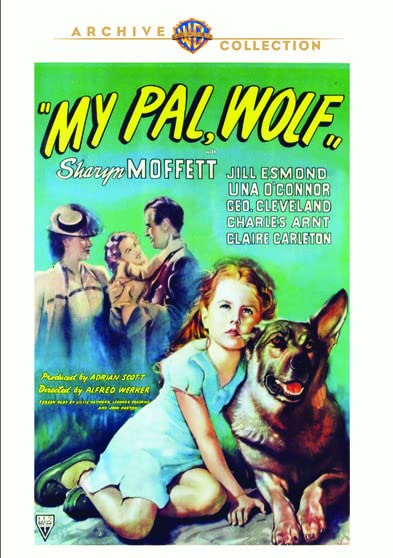
Sometimes, you never know what the true premise of a motion picture may turn out to be. This can be particularly relevant when it comes to old B movies ‒ wherein even a man taking a leisurely stroll down to the corner market for a pack of cigarettes can end with an overzealous example of religious superiority, all but demanding viewers go to church that Sunday. Why, even a simple family movie about a little girl and her pet dog can begin as one kind of tale before it ultimately transforms into something wholly other. And wouldn’t you just know it, that’s exactly what happens in My Pal Wolf ‒ a 1944 production from RKO Radio Pictures and director Alfred L. Werker (The Adventures of Sherlock Holmes, The Last Posse).
Here we witness the big screen debut of one-time child starlet Sharyn Moffett. The name may not ring an immediate bell to most, but Little Miss Moffett also appeared in such notable RKO productions as Val Lewton’s The Body Snatcher, and as Cary Grant and Myrna Loy’s daughter in the unforgettable Mr. Blandings Builds His Dream House before her onscreen acting career dissolved altogether (a fate akin to her own kin, younger actor brother Gregory, who is best known today as being the child “hero” in Phil Tucker’s immortal Robot Monster). But, much like the message of My Pal Wolf itself, we don’t immediately know young Sharyn is the film’s protagonist. Instead, it seems like second-billed Jill Esmond is the main character.
Hired by a successful businesswoman (former Broadway actress Leona Maricle) to look after and essentially raise her daughter at a remote country estate, Ms. Edmond is given the Jonathan Harker role: she is assigned with a task to perform way out in the middle of nowhere, only to meet obstacle after obstacle in the guise of quirky locals Claire Carlton, Una The Bride of Frankenstein O’Connor (who probably turns in the film’s best performance outside of canine co-star Grey Shadow), future Lassie TV series co-star George Cleveland, and the venerable Charles Arnt; and an unruly monster who likes to venture out at night. The story then casts its light on the aforementioned beast ‒ little Sharyn Moffett ‒ who goes from being the story’s problem child to misunderstood tomboy in a flash.
Following this transition, Ms. Esmond becomes the film’s villainess ‒ attempting to tame the wild heart of young Miss Moffett, who has befriended a presumably feral wolfdog with an above-average understanding of not only the English language, but commands given by the humans who speak it. Naturally, this cannot be mere coincidence, and it is not: “Wolf” is actually an escapee from a nearby US Army canine kennel, where they train the doggies to perform various tasks on and around the battlefields of Europe (because there’s a war going on, no matter what the happy young boys and girls out in the country may be up to). Upon learning the truth of the situation, our dog-hating villainess reports the lost dog to the nearby military compound, which begins a weird and severely underplayed rescue mission of sorts.
It isn’t until the final act of My Pal Wolf that the true message is delivered to us all. At first, it seems like blatant war propaganda (and I suppose, in some respects, it is), but rather, the movie attempts to teach its young audience that certain sacrifices must be made in life. And especially during war. Edward Fielding, an actor of both stage and screen who usually played physicians or members of authority in films such as The Pride of the Yankees, Fritz Lang’s Ministry of Fear, and Alfred Hitchcock’s Rebecca and Spellbound (Fielding was also one of cinema’s first Dr. Watsons), gets the unenviable job of delivering this message to Miss Moffett (but really the children whose loved ones were off trying to make the world a better place) as the grandfatherly Secretary of War.
The movie concludes with an additional message ‒ however subtle it may be to some ‒ reminding us the future lies in the youth of our world. And while the film’s execution may not be entirely smooth (it was made for children and families, after all), My Pal Wolf still manages to bring in the news from the outside stoop. The Warner Archive Collection has rescued this canine classic ‒ one of many motion pictures produced after the success of the original Lassie Come Home the year before ‒ to DVD as a Manufactured-on-Demand release. The presentation for this enjoyable time-waster is quite nice, presenting the photoplay in its intended 1.37:1 Academy aspect ratio with 2.0 mono audio accompanying. No special features are to be found here, but hey, certain sacrifices have to be made, right?